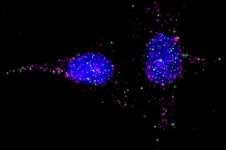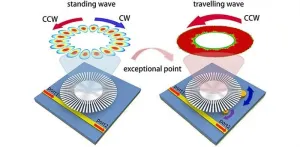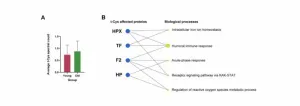(Press-News.org) One in every three FDA-approved drugs targets a single superfamily of receptors dotting the surfaces of human cells. From beta blockers to antihistamines, these essential, life-saving medications trigger winding biochemical pathways, via these receptors, to ultimately prevent a heart attack, or stop an allergic reaction in its tracks.
But scientists have learned that their story is much more complicated than initially believed—a number of these drugs are in fact targeting a complex composed of one receptor and one associated protein. Now, a new study in Science Advances introduces a novel approach to mapping the interactions between 215 such receptors and the three proteins that they form complexes with. The findings dramatically expand understanding of these interactions and their therapeutic potential.
“On the technical side, we can now study these receptors at unprecedented scale,” says first author Ilana Kotliar, a former graduate student in Rockefeller’s Laboratory of Chemical Biology and Signal Transduction, headed by Thomas P. Sakmar. “And on the biological side, we now know that the phenomenon of these protein-receptor interactions is much more widespread than originally thought, opening the door to future investigations.”
Uncharted territory
This family of receptors are known as GPCRs, or G protein-coupled receptors. Their accessory proteins are known as RAMPs, short for receptor activity-modifying proteins. RAMPs help transport GPCRs to the cell surface and can vastly alter how these receptors transmit signals by changing the receptor’s shape or influencing its location. Because GPCRs seldom exist in a vacuum, identifying a GPCR without accounting for how RAMPs might influence it is a bit like knowing the menu of a restaurant without checking its hours, address or delivery options.
“You could have two cells in the body in which the same drug is targeting the same receptor—but the drug only works in one cell,” says Sakmar, the Richard M. and Isabel P. Furlaud Professor. “The difference is that one of the cells has a RAMP that brings its GPCR to the surface, where that the drug can interact with it. That’s why RAMPs are so important.”
Knowing this, Sakmar and colleagues were determined to develop a technique that would allow researchers to parse out each RAMP’s effect on every GPCR. Such a comprehensive map of GPCR-RAMP interactions would supercharge drug development, with the added benefit of possibly explaining why some promising GPCR drugs mysteriously haven’t panned out.
They hoped that such a map would also contribute to basic biology by revealing which natural ligands several so-called “orphan” GPCRs interact with. “We still don’t know what activates many GPCRs in the human body,” Kotliar says. “Screenings may have missed those matches in the past because they weren’t looking for a GPCR-RAMP complex.”
But wading through every GPCR-RAMP interaction was a daunting task. With three known RAMPs and almost 800 GPCRs, searching through every possible combination was impractical, if not impossible. In 2017 Emily Lorenzen, then a graduate student in Sakmar’s lab, began a collaboration with scientists at the Science for Life Laboratory in Sweden and Sweden’s Human Protein Atlas Project to create an assay capable of screening for GPCR-RAMP interactions.
Hundreds of experiments at once
The team started by coupling antibodies from the Human Protein Atlas to magnetic beads, each pre-colored with one of 500 different dyes. These beads were then incubated with a liquid mixture of engineered cells expressing various combinations of RAMPs and GPCRs. This setup allowed researchers to simultaneously screen hundreds of potential GPCR-RAMP interactions in a single experiment. As each bead passed through a detection instrument, color coding was used to identify which GPCRs were bound to which RAMPs, enabling high throughput tracking of 215 GPCRs and their interactions with the three known RAMPs.
“A lot of this technology already existed. Our contribution was an enabling technology built upon it,” Sakmar says. “We developed a technique to test for hundreds of different complexes at once, which generates a huge amount of data, and answers many questions simultaneously.”
“Most people don’t think in multiplex terms. But that’s what we did—500 experiments at once.”
While this work is the culmination of a team effort over a long period of time, Kotliar made herculean efforts to drag it across the finish line—shuttling samples and scarce reagents back and forth from Sweden in rare travel windows during COVID.
It paid off. The results provide a handful of long-awaited resources for GPCR researchers and drug developers: publicly available online libraries of anti-GPCR antibodies, engineered GPCR genes and, of course, the mapped interactions. “You can now type in your favorite receptor, find out what antibodies bind to it, whether those antibodies are commercially available, and whether that receptor binds to a RAMP,” Sakmar says.
The findings increase the number of experimentally identified GPCR-RAMP interactions by an order of magnitude and lay the groundwork for techniques that could help detect combinations of GPCRs and identify harmful autoantibodies. “Ultimately, it’s a technology-oriented project,” Sakmar says. “That’s what our lab does. We work on technologies to advance drug discovery.”
END
This new technique for studying cell receptors could have sweeping implications for drug development
2024-08-27
ELSE PRESS RELEASES FROM THIS DATE:
Bringing environmental justice to disadvantaged communities
2024-08-27
COLUMBUS, Ohio – Not all communities in the United States face the same risks for environmental problems such as air pollution, noise and wastewater. But how can federal agencies fairly identify which areas deserve the most help?
A new consensus study report from the National Academies of Sciences, Engineering and Medicine (NASEM) offer recommendations for developing tools that can help answer that question.
“Our job was to create methods to identify disadvantaged communities that most need federal resources to address environmental justice issues,” said Harvey Miller, ...
Wiener studying learning & metacognition for the perception of time
2024-08-27
Wiener Studying Learning & Metacognition For The Perception Of Time
Martin Wiener, Associate Professor, Psychology, College of Humanities and Social Sciences (CHSS), received funding to study learning and metacognition for the perception of time.
Via this research, Wiener will conduct a series of studies that will inform metacognition and interval timing. He holds that this work will lead to a new domain of study to further understand how humans learn and adapt to temporal intervals.
By understanding how the brain measures and learns intervals of time, we can better understand ...
Dumas receives funding for study of how distinct NMDA receptor signaling domains regulate hippocampal network dynamics
2024-08-27
Dumas Receives Funding For Study Of How Distinct NMDA Receptor Signaling Domains Regulate Hippocampal Network Dynamics
Theodore Dumas, Associate Professor, Psychology, College of Humanities and Social Sciences (CHSS), received funding for the project: “Distinct NMDA receptor signaling domains regulate hippocampal network dynamics.
Dumas and his collaborators hypothesize that in wildtype mice, NMDA receptors regulate hippocampal network oscillatory activity (slow gamma frequency) in the absence of ion conductance (nonionotropic) and that enhancing GluN2B subunit-type nonionotropic signaling will increase slow gamma power and enhance spatial memory retrieval.
The researchers ...
Second genetic sensor for DNA methylation discovered
2024-08-27
DNA methylation is a process in which a methyl group is attached to the cytosine base of the DNA molecule, and a major way that DNA is epigenetically marked. Epigenetic modifications can act as on-off switches to regulate gene expression and help generate diverse cell types without changing the underlying DNA sequence. It is how the body ensures that brain-related genes don’t get turned on in heart cells, for example.
For this reason, maintenance of the DNA methylation pattern is important to ensure the correct and consistent function of each cell type. But this is no easy feat: the DNA methylation pattern can change over time, and this is linked to a variety of diseases. One ...
New sensor technology enhances detection of tiny particles
2024-08-27
In recent years, advances in photonics and materials science have led to remarkable developments in sensor technology, pushing the boundaries of what can be detected and measured. Among these innovations, non-Hermitian physics has emerged as a crucial area of research, offering new ways to manipulate light and enhance sensor sensitivity. A recent study published in Advanced Photonics Nexus reports a breakthrough in this field, presenting a new type of sensor that leverages exceptional points (EPs) to achieve unprecedented levels of sensitivity.
This study introduces a highly sensitive and reconfigurable sensor based on a single ...
New technology ‘lights up’ bacteria in wounds for better infection prevention
2024-08-27
LOS ANGELES — Over 6.5 million Americans experience chronic wounds — wounds that do not heal after a few months. Almost all such wounds contain bacteria, which, if not detected and removed, can lead to severe infection and resulting complications, including amputation if a limb is involved.
This is especially true for patients with diabetic foot ulcers (open sores), which affects one-third of people with diabetes. Approximately 20% of those who develop a diabetic foot ulcer will require a lower-extremity amputation, according ...
UCLA receives $120 million from Alya and Gary Michelson for new California Institute for Immunology and Immunotherapy
2024-08-27
UCLA has received a $120 million commitment from surgeon, inventor and philanthropist Dr. Gary Michelson and his wife, Alya, to kick-start the California Institute for Immunology and Immunotherapy, an innovative public-private partnership aimed at spurring breakthrough discoveries that prevent and cure diseases and catalyze economic growth and innovation in Los Angeles.
Michelson, a spine surgeon and prolific inventor who holds nearly 1,000 individual patents, is co-founder and chair of the board of the institute, which will be housed at UCLA’s state-of-the-art research park.
The gift, distributed via ...
Dunick receives funding for Center For Economic Education
2024-08-27
Dunick Receives Funding For Center For Economic Education
Jason Dunick, Associate Chair and Term Associate Professor, Economics, College of Humanities and Social Sciences (CHSS), received $108,692 from Virginia Council on Economic Education for: “Center for Economic Education.”
Dunick will use this funding to support the continuation of the services of the Center for Economic Education. The Center supports K-12 teachers who are teaching economics and personal finance in Virginia.
This grant represents the renewal of a long-standing relationship with the ...
National Institutes of Health awards $2.4 million grant to cross-disciplinary team of researchers to study psychedelics for methamphetamine addiction
2024-08-27
FOR IMMEDIATE RELEASE
Media Contacts:
Colleen McDonald
Sr. Consultant, Earned Media
Kara Reed
Director of Development
Lisa Babin
Executive Director of Communications
Medical College of Wisconsin
University of California San Diego
LSU Health Shreveport
414.801.3146 | cmcdonald@mcw.edu
217.390.6629 | k3hendrickson@ucsd.edu
318.675.8769 | lisa.babin@lsuhs.edu
Milwaukee, Wis., August 27, 2024 – John McCorvy, PhD, Assistant Professor in the Department ...
Trioxidized cysteine and aging: Beyond proteinopathic paradigms
2024-08-27
“The results indicated a significant increase in cumulative t-Cys levels and the total number of t-Cys residues in aging and aged mice proteomes compared to young groups.”
BUFFALO, NY- August 27, 2024 – A new research perspective was published in Aging (listed by MEDLINE/PubMed as "Aging (Albany NY)" and "Aging-US" by Web of Science), Volume 16, Issue 15 on July 25, 2024, entitled, “Trioxidized cysteine and aging: a molecular binomial that extends far beyond classical proteinopathic paradigms.”
Oxidative stress (OS) - characterized by an imbalance between oxidants and antioxidants - leads to the formation ...




